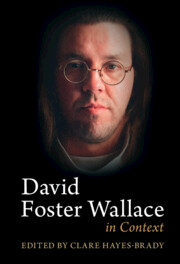Book contents
- David Foster Wallace in Context
- David Foster Wallace in Context
- Copyright page
- Contents
- Figures
- Contributors
- Acknowledgments
- Abbreviations
- Introduction
- Part I Contexts
- Chapter 1 David Foster Wallace and Narratology
- Chapter 2 A Meeting of Minds
- Chapter 3 Writing in a Material World
- Chapter 4 Confidence Man
- Chapter 5 David Foster Wallace and European Literature
- Chapter 6 David Foster Wallace and Poetry
- Chapter 7 David Foster Wallace’s “Non”-Fiction
- Chapter 8 “Thanks Everybody and I Hope You Like It”
- Chapter 9 David Foster Wallace and Visual Culture
- Part II Ideas
- Part III Bodies
- Part IV Systems
- Works by David Foster Wallace
- Bibliography of Secondary Sources
- Index
Chapter 4 - Confidence Man
David Foster Wallace and the American Nineteenth Century
from Part I - Contexts
Published online by Cambridge University Press: 18 November 2022
- David Foster Wallace in Context
- David Foster Wallace in Context
- Copyright page
- Contents
- Figures
- Contributors
- Acknowledgments
- Abbreviations
- Introduction
- Part I Contexts
- Chapter 1 David Foster Wallace and Narratology
- Chapter 2 A Meeting of Minds
- Chapter 3 Writing in a Material World
- Chapter 4 Confidence Man
- Chapter 5 David Foster Wallace and European Literature
- Chapter 6 David Foster Wallace and Poetry
- Chapter 7 David Foster Wallace’s “Non”-Fiction
- Chapter 8 “Thanks Everybody and I Hope You Like It”
- Chapter 9 David Foster Wallace and Visual Culture
- Part II Ideas
- Part III Bodies
- Part IV Systems
- Works by David Foster Wallace
- Bibliography of Secondary Sources
- Index
Summary
Though lauded as radically generically innovative, David Foster Wallace’s work – both in characteristics and range – has a number of antecedents in nineteenth-century Anglophone and other traditions, which ultimately illuminate the relationship between the two main hallmarks of his work: ethical gesture and stylistic complexity. As his reviews and comments on other authors and cultural trends make clear, Wallace was both a debunker of grand claims (in the manner of the Melville who said Emerson gave the impression that “had he lived in those days in which the world was made, he might have offered some valuable suggestions”) and a maker of such claims himself. He was obviously deeply indebted to – and may even have represented a baroque final development of – a consistent nineteenth-century American emphasis (strengthened through the movement for the abolition of slavery) on sympathetic identification as a primary social resource. Wallace combines nineteenth-century literary figures’ blend of the essayistic with the fundamental trajectory of the bildungsroman, within fiction and nonfiction. Through an analysis of Wallace’s forebears and influences, focusing on the American nineteenth century, this chapter proposes that Wallace in fact played the role of a nineteenth-century novelist (at once cultural commentator and artist) in a postmodern context. While Wallace’s ethics always seems starkly accessible, his brand of literariness does not. This is because he brings two central animating features of nineteenth-century American writing’s interventions to their most acute, impossible point: Sympathy becomes incapacitating dissolution, and educative realism approaches unreadability. Understanding this background also provides a new context for the recent diminution of Wallace’s personal reputation: His ethical appeals are not only a hypocritical contrast to private conduct but also an indispensable strategy for a formal obscurity that still sought transformative relevance.
Keywords
- Type
- Chapter
- Information
- David Foster Wallace in Context , pp. 46 - 56Publisher: Cambridge University PressPrint publication year: 2022



